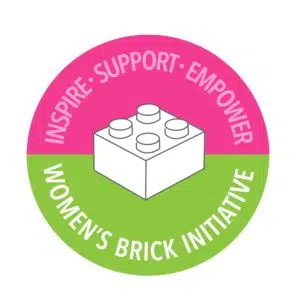Part 1 of this discussion presents an overview of cultural representation within LEGO Minifigures, exploring the distributions by region, gender, and flesh tone color for minifigs that are explicitly inspired by a specific culture. Part 1 also provides background on the data collection and categorization processes. In Part 2, we delve into a specific nuance of the design of cultural minifigs: head repetition.
While gathering our cultural minifigs data, we noticed that some of the heads look more familiar than others. In other words, these heads have been repetitively used to represent certain cultures or even across different cultures. In this analysis, we explore what these repeated heads look like and which culture(s) they “belong to”. Since Ninjago and Monkie Kid are the two largest categories of cultural minifigs in our data, we looked at these two themes separately as a starting point before extending our investigation into the general cultural minifigures.
Ninjago
We first filtered to only minifigs with inspiration “Ninjago” or “The LEGO Ninjago Movie”. (Inspiration is a variable that stores the movie/film/theme that a particular minifig was created under, if any.) There are in total 448 Ninjago minifigs, which parts descriptions we subsequently scrapped and filtered to just the heads. (Note that we left out 10 minifigs whose parts descriptions were not available.) At this point, we counted by part number to get the number of unique heads—164 adult heads and 1 baby head. Then, we computed how many heads were used outside of Ninjago by subtracting the number of Ninjago minifigs from the number of total minifigs for each head; this result yielded that 43 heads were reused outside of Ninjago.
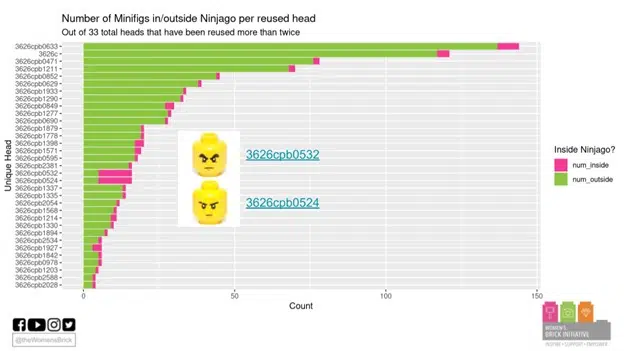
The graph above shows the distribution of the 33 heads in Ninjago that have been reused more than twice in terms of the number of times that they were used in/outside the Ninjago theme. We can easily see that all heads except for two were mostly reused outside of Ninjago. These two heads are characters Cole (3626cpb0532) and Jay (3626cpb0524) in Ninjago.
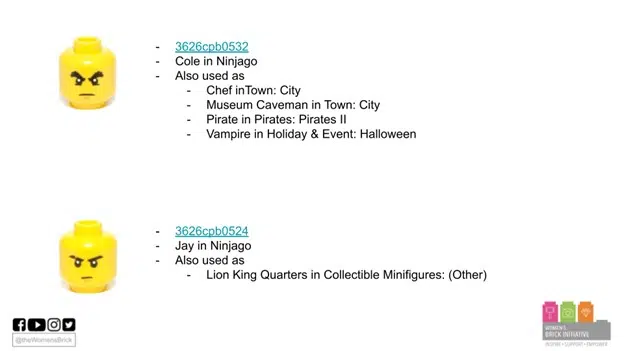
We wondered what genders these reused minifigure heads were represented in. So, in the graph below, we colored the bars by gender rather than whether this portion of heads are used in/outside Ninjago. Note that we were keeping the data and the ordering of the heads—the number of times they were being reused—the same as they were in the previous graph.

Observe how the upper half of the graph has more pink/orange bars while the lower half has more green bars. This implies that of the Ninjago heads that were reused more than twice, female/neutral heads were in general being reused more than male heads.
Now, we are going to delve deeper into the most reused female head in the graph above—part 3626cpb0633.

The Ninjago head that has been reused the most (inside AND outside Ninjago combined) was reused 144 times in total. It is interesting that this head was most often used in the Town category, in which minifigs are generic, assumed to be white and/or European (as opposed to Japanese or broader Asian).
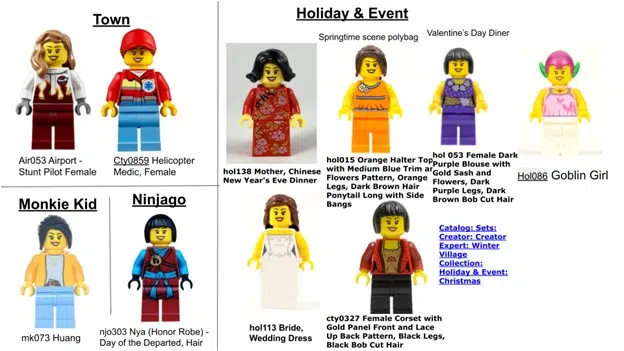
The image above is a comparison of head 3626cpb0633 among Town, Holiday & Event, and Ninjago sets. Some minifigs (e.g. cty0327) are themselves from Town: City category, but we were classifying them based on the sets they are found in (e.g. Holiday & Event: Christmas).
Monkie Kid
Similarly, we did analysis on the minifigs produced under inspiration of the Monkie Kid theme. Though being the second largest category in cultural minifigs, the Monkie Kid minifigs have a sufficiently smaller population than does Ninjago ones. There are only 54 minifigs, and our analysis was based on 51 of them because the part information was not available for 3. Out of the 51 minifigs, there were 30 unique heads, in which 5 heads were overlapping between Monkie Kid and Ninjago.

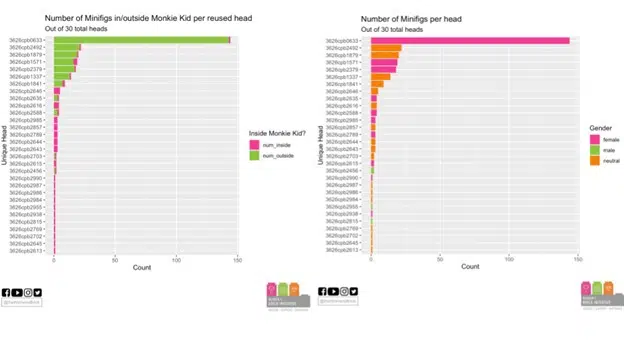
Similarly to the graphs for Ninjago, the bar charts above display the distribution of frequency of repetition for all 30 heads colored by inside/outside Monkie Kid (left) and gender (right). Note that the most reused head in Monkie Kid (3626cpb0633) is the same as the most reused head in Ninjago.
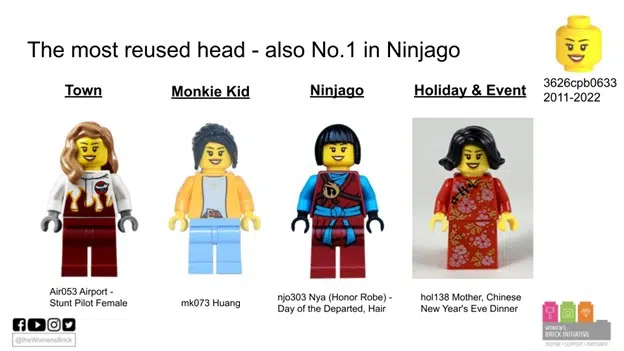
It is notable that there are many more neutral heads than other genders and surprisingly very few male heads in Monkie Kid, as the bars in the graph on the right are mostly colored in pink and orange.
Other Cultural Minifigs
At last, we looked at all other cultural minifigs that are left (excluding Ninjago and Monkie Kid) and did some within-group as well as across-groups comparisons. There are 183 minifigs in our “Others” category in total, in which we based our analysis on 178 heads (leaving out some minifigs with unavailable part info). We found 123 unique heads and only 2 of them repeated across multiple regions (within the realm of “Others”).

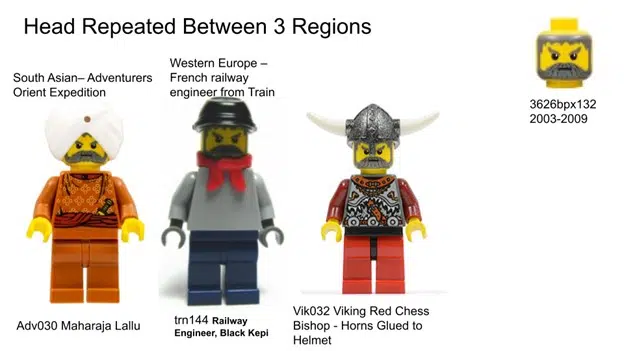
When we cross-compared “Others” with Ninjago, we found 7 heads overlapping. Most of them were simultaneously used in the Chinese New Year sets.
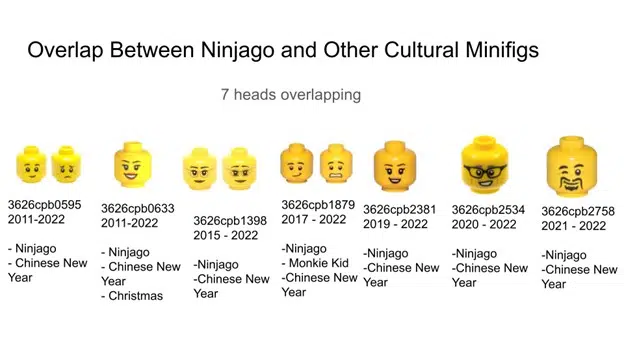
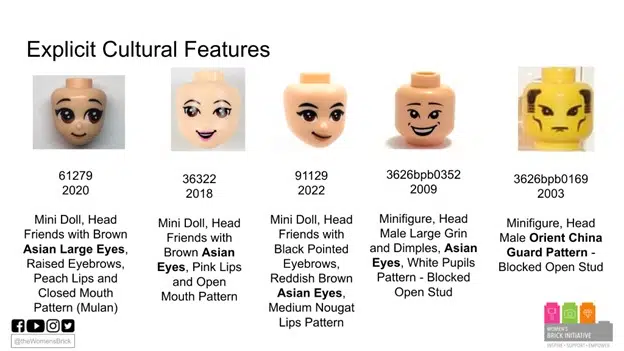
Finally, we noticed some facial/expression-wise identifying keywords present in the descriptions of certain – mostly (east) Asian – cultural minifigure heads. Analogous to how male is the default gender, the default culture seems to be western European in naming conventions. On the one hand, LEGO does not acknowledge differences in regional features in using the same head for multiple regions, and on the other hand LEGO highlights the “otherness” of non western european cultures by labeling features when they intend them to be of a non-european culture. The use of the label “Asian Eyes” is harmful not only in that it highlights the “otherness” of a non-European feature, but also because it sends the message that the eyes of all Asian people look the same when Asia is an extremely large and diverse continent. This calls out to LEGO the necessity of being more aware of the cultural stereotypes and defaults that they have been reinforcing and highlights an opportunity for positive change toward more respectful representation.
Limitations and Opportunities for Future Analysis
The issue of cultural representation in LEGO is broad and nuanced, and there are many critical aspects of it that we have not addressed. Thus far, we have mainly included minifigs in our analysis, and it would be beneficial to also look at how cultures are represented in Mini Dolls and Duplo minifigures. These categories specifically would be interesting to explore because they both have a much wider range of diversity than traditional minifigs, yet many of the design and labeling choices made with regard to representing diverse cultures have been disrespectful.
Furthermore, we failed to include the minifigs based on Black Panther/Wakanda in this analysis, and it is essential to include those in order to observe how LEGO has chosen to represent African cultures.
It would also be beneficial to conduct more in-depth qualitative analyses on the design and labeling choices used to represent various cultures, as this analysis has been more of a broad overview. We have pointed out a few specific opportunities for improvement such as the use of the same heads across multiple very different cultures and the explicit labeling of “Asian Eyes”, yet there are many more that must be highlighted in order to enact change.
Overall, this two-part analysis of cultural representation in minifigs serves as a starting point in addressing this complex issue, and in order to move toward equitable and respectful representation of all people of the world within LEGO, it is essential to continue to dig deeper in order to highlight more specific areas where the company can improve.
If you have noticed examples either of inaccurate/disrespectful or of especially positive/respectful representation in minifigs/minidolls, leave them in the comments below and tell us about your experiences!
